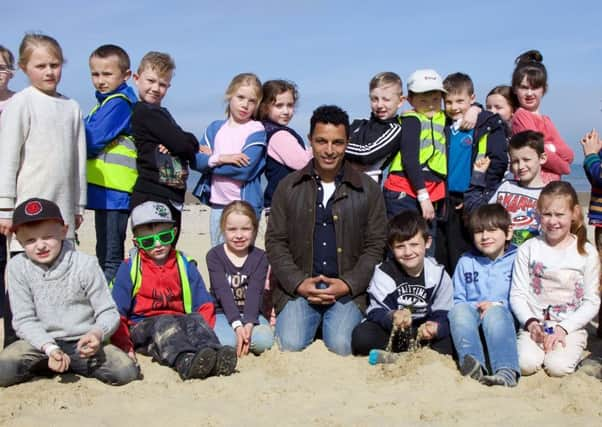Jane Bradley: Schools are following wrong gender agenda


When I was in the oldest class at primary school, my teacher, generally a very nice man, called all of us girls to stay behind one break time.
He’d noticed that we had been playing football in the school yard, he said - and it worried him.
Advertisement
Hide AdAdvertisement
Hide AdWe weren’t strong enough to play football with the boys, he told us. Then, blushing, he warned us that if we were injured playing football, it might prevent us from having children later in life.
Of course, looking back, it was absolutely ludicrous - though I have no doubt he was doing it with the kindest of motives, if the most insanely misguided medical knowledge. I have no idea why we didn’t all run home immediately and tell our parents - and why they didn’t kick up the most almighty of rucuses at school. If it happened today, there would be an outcry.
But it was the 80s, we were ten years old and we just listened sagely to what he said and stopped joining in the dangerous sporting activity, returning to our sensible, girlish games of skipping and tig while the boys ran around the football field.
Sexism has come a long way in 30 years. Everyone is very much more aware that it is not acceptable for girls to be banned from a playground football game.
Yet, it still goes on, in the most subtle and unconscious of ways. In adult life, there is still a gender pay gap, while women occupy less than a quarter of UK board positions. Although we might think we have gone a long way towards stamping out sexism, there is still a long way to go.
In my daughter’s class at school, the children are already very consciously - on the part of the pupils, but probably quite unconsciously by the teaching staff - divided into boys and girls. The girls hang their coats on one type of coloured peg, the boys on another. When they leave at the end of the day to be delivered to waiting parents, there are two lines - one of girls and one of boys. The reason, the staff have explained to the children, is so it is easier to see who has left and who hasn’t, so they split them into two, sending the lines out one at a time.
My friend’s son’s school does the same when the children are sent into the dining hall for lunch - a boys’s line and a girls’s line, while the separate peg or cupboard for bags and coats seems endemic throughout the primary school system.
It may all seem harmless and of course one group is not told they are any better than the other, but it draws a dividing line between the genders at an age when it has been proven that can have a damaging effect.
Advertisement
Hide AdAdvertisement
Hide AdA fascinating documentary series which began on BBC Two last week looked at how seven year old boys and girls view themselves and each other.
In the programme,‘No More Boys And Girls: Can Our Kids Go Gender Free?’ a class of children living on the Isle of Wight were interviewed about their opinions on who was stronger, cleverer, better at games.
The boys constantly had a high opinion of their abilities - yet both sexes regarded the girls as weaker in every respect.
An experiment involving a fairground “strong man” game - where the children had to hit a target with a mallet as hard as possible, proved particularly interesting. The boys were all convinced that they would score 10. Most of the girls, however, were far more conservative, their estimates ranging mainly between two and five.
The presenter explained that at the age of seven, indeed until youngsters reach puberty, there is no physical difference in strength between male and female children. Meanwhile, a brain scan experiment showed that there no such thing as a female or male brain.
Yet the children in the class were all convinced that a discrepency existed - until they played the game and their equal strength became evident. The over-confident boys were distraught, the self-deprecating girls delighted.
When the presenter, Dr Javid Abdelmoneim, investigated how the youngsters were treated, the children were split by gender on a daily basis.
Interestingly, the class’s teacher, again a nice man, not unlike my well-meaning teacher of the 80s, constantly drew attention to the difference between girls and boys.
Advertisement
Hide AdAdvertisement
Hide AdHe called the girls “love” and the boys “mate”, multiple times a day. They, like children in my own daughter’s class, had to hang their coats in separate spaces, splitting them into gender groups from the minute they walked into the classroom.
For six weeks, they were treated the same - playing the same sports, reading the same books and putting their coats in the same cupboard, which was repainted a gender neutral orange.
Interestingly, after the experiment, the difference between the children’s self esteem, when scored by a psychologist, dropped dramatically, from eight per cent to 0.2 per cent.
The experiment did not suggest that girls or boys should be forced to do anything differently - in terms of dress or choice of play. Despite social media backlash, it was not making the children “gender neutral”, it was just trying to treat them exactly the same. Yet just by simply removing regular references to their gender, they began to regard themselves as equals.
There is no reason why any of this has to be done by gender, in any school.
The separate entrances for boys and girls from Victorian days - the words still visible on many an historic school building in Edinburgh - are used no more.
Lessons should be learned from this experiment and replicated in primary schools across the country.
Boys and girls are not gender neutral, but they are gender equal.